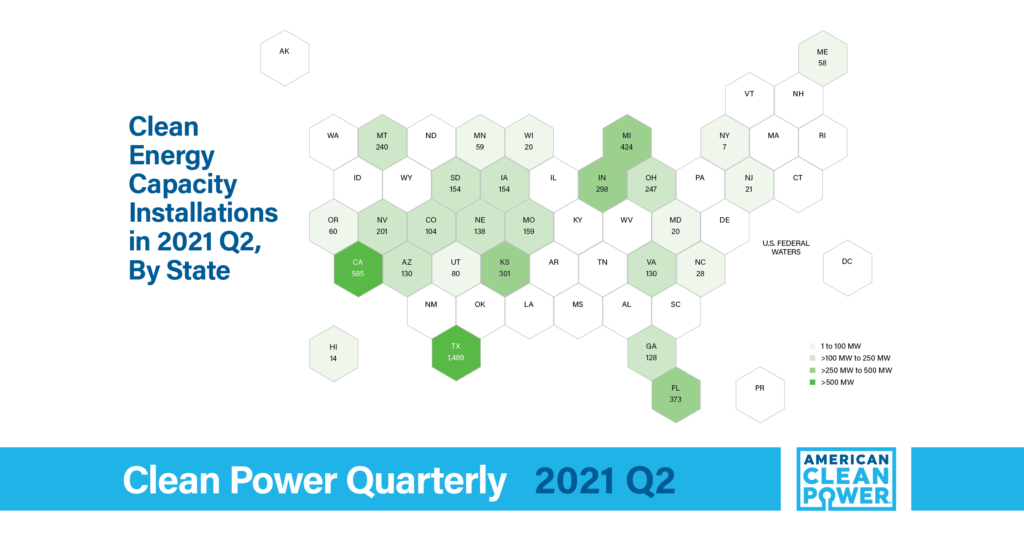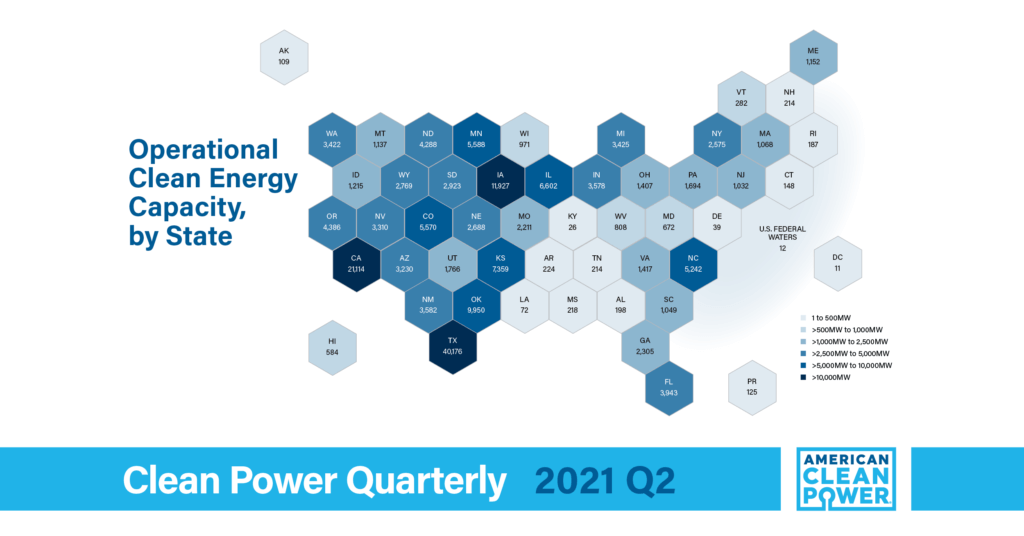Following a year of record clean power installations in 2020, the pace of growth has continued into 2021 with the second quarter reaching a record high commissioning rate. Last quarter saw 5,620 MW of new wind, solar and energy storage capacity brought online across the country. This represents the highest second quarter on record and a 13 percent increase over 2020’s second quarter volume. Impressively, this brings the first half of the year already to 9,915 MW, which is a 17 percent increase compared to the same period last year. These are among the top-line takeaways from The Clean Power Quarterly 2021 Q2 report, released this week by the American Clean Power Association (ACP).
Wind and solar installations in Q2 are closely tied with 2,824 MW and 2,226 MW brought online, respectively. New battery energy storage totaled 570 MW in Q2, which was the largest growth rate of all three technologies, representing a 439 percent surge over Q1 energy storage installations. Energy storage is taking off thanks to significant cost reductions in recent years and a modernizing electric grid and power marketplace that increasingly benefits from the resource flexibility and time-shifting offered by energy storage. On a related note, ACP and the U.S. Energy Storage Association (ESA) announced this week that ESA’s member companies approved the merger to join ACP effective January 1, 2022.
Project developers installed 16 new wind projects, 30 utility-scale solar projects, seven energy storage projects and three solar-storage hybrid projects from April to June. No surprise to anyone at this point, Texas again tops the list of states adding the most clean power with 1,489 MW, followed by California (585 MW), Michigan (424 MW), Florida (373 MW) and Kansas (301MW).

In total, there are now over 180,216 MW of clean power capacity operating in the U.S, enough to power over 50 million homes across the country. This amount of clean power is more than double U.S. capacity just five years ago. Cumulative wind capacity increased to 127,804 MW and represents the largest share of renewable power capacity on the grid. Utility solar capacity comes in third, after hydroelectric, with 48,894 MW. Battery storage is at a nascent 2,527 MW but is growing quickly.

This growth and expansion will continue as more clean power projects are set to come online during the remainder of 2021. At the end of the second quarter there were 906 projects totaling over 101,897 MW of clean power capacity under construction (37,725 MW) or in advanced development (64,172 MW) across the United States. ACP considers advanced development to be projects with a significant equipment order, a signed power purchase agreement (PPA) or announcement to proceed from a regulated utility. Solar represents the largest share of capacity in the clean power pipeline, accounting for 54 percent, followed by land-based wind (23 percent), offshore wind (14 percent), and battery storage (9 percent).

The second quarter of 2021 proved to be a consequential one for U.S. offshore wind with a series of actions from the Bureau of Ocean Energy Management (BOEM) and other entities. BOEM provided its Record of Decision (ROD) for Vineyard Wind. This final major step in the federal review process will allow the 800 MW project off the coast of Massachusetts to move forward and would represent the first large-scale commercial project built in U.S. federal waters. BOEM also announced plans to begin environmental review of Revolution Wind’s 880 MW project off the coast of Massachusetts and Rhode Island and further announced its intent to lease eight new offshore development areas off the New York coast. In May, the White House and the Department of Interior (DOI) announced an effort to advance new offshore wind areas off California’s northern and central coasts and identified two areas that could generate approximately 4.6 GW of electricity and power 1.6 million homes, and further interest in the offshore potential of the Gulf of Mexico.
ACP closely tracks a wide range of market activity in the clean power sector and provides key data and context in its quarterly reports. Underlying data can be accessed with CleanPowerIQ, ACP’s flagship data product. For the latest, click the following link for the Clean Power Quarterly 2021 Q2 report.
Author:
John HensleyVice President, Research & Analytics [email protected]


